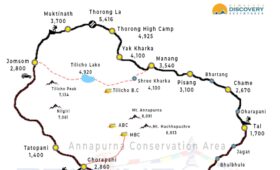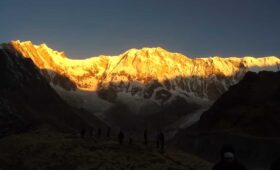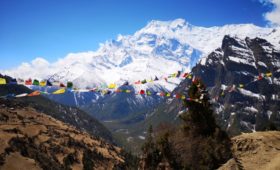Annapurna Circuit Trek in August is a must-do for any enthusiastic trekker from all over the world. The Annapurna Circuit Trek is one of the most popular and rewarding trekking routes in Nepal. It takes you through a diverse range of landscapes, from lush green valleys and terraced fields to high mountain passes and alpine landscapes.
The trek begins in Besisahar, a town located in the Lamjung District of Nepal, and follows a counter-clockwise route around the Annapurna Massif. It takes you through the Marsyangdi Valley, crosses the Thorong La Pass (5,416 meters/17,769 feet), and descends through the Mustang region, eventually joining the Kali Gandaki River.
Annapurna Circuit Trek in August offers breathtaking views of snow-capped peaks, including Annapurna I (8,091 meters/26,545 feet), Dhaulagiri (8,167 meters/26,795 feet), and Machhapuchhre (6,993 meters/22,943 feet). The typical duration for the Annapurna Circuit Trek is around 10 to 16 days, depending on your pace and acclimatization needs.
Annapurna Circuit Trek Weather in August
The Annapurna Circuit Trek in August, our recent trek group were August to mid-September. This might come as a shock to everyone, but our group didn’t experience much rain at all.
Our recent group estimate a total of 3-4 days rain across our total 12 days trek. So, monsoon rains did not prove to be a big issue for August based on our last year 2022 experience. The weather conditions changed dramatically during these 12 days trek 2022, as group moved through different heights and regions.
Temperatures in high passes such as Thorong La (5416 meters) can reach -4 degrees Celsius during August. The rest of the Annapurna Circuit is fairly warm in comparison. The daytime temperature is 18-24 degrees Celsius below 2500m. The temperature drops from 2500 to 4000 meters feels slightly colder. The average temperature is 9 to 13 degrees Celsius.
 Things to Consider Before Hiking the Annapurna Circuit
Things to Consider Before Hiking the Annapurna Circuit
Annapurna Circuit Trek in August can be an incredible adventure, but it’s important to prepare properly and take necessary precautions to ensure your safety and enjoyment. Here are few things to consider:
- Physical Fitness: The Annapurna Circuit Trek is a moderately challenging trek that involves walking for several hours a day, often at high altitudes. You should be reasonably fit and healthy before attempting this trek.
- Altitude Sickness: Altitude sickness can affect anyone, regardless of their fitness level. It’s important to acclimatize properly to the higher altitude by taking rest days, drinking plenty of water, and listening to your body. Be aware of symptoms such as headache, dizziness, and nausea, and seek medical help if necessary.
- Weather and Seasons: The Annapurna Circuit Trek is best done during the autumn and spring seasons when the weather is mild and the skies are clear. However, weather patterns can be unpredictable, so be prepared for rain and cold temperatures.
- Permits: You will need permits to trek in the Annapurna Conservation Area. Make sure to obtain the necessary permits and carry them with you at all times.
- Accommodation and Food: There are many teahouses along the Annapurna Circuit route where you can stay and eat. However, it’s important to be aware that the quality of accommodation and food can vary widely. Make sure to check the cleanliness of the teahouses and food preparation practices.
- Equipment: Proper gear is essential for a comfortable and safe trek. Make sure to bring sturdy and comfortable hiking boots, warm clothing, a waterproof jacket, a hat, gloves, a sleeping bag, a backpack, and any other essential items.
Detailed Itinerary of Annapurna Circuit Trek in August
Day 1: Arrive in Kathmandu.
Upon arrival, you will be greeted at the airport by our airport representative. She/he will assist you with the necessary arrangements and transfer you to your hotel in Kathmandu. You can rest and relax throughout the day.
Day 2: Drive from Kathmandu to Chame
After an early breakfast, you will embark on a scenic drive from Kathmandu to Chame. The journey takes around 10 to 11 hours, covering a distance of around 270 km. Along the way, you’ll pass through beautiful landscapes, lush valleys, and charming villages. Upon reaching Chame, located at an elevation of 2,710 meters (8,891 feet), you will check into your accommodation and prepare for the trek ahead.
Day 3: Trek from Chame to Pisang
Today, you will begin your trek from Chame to Pisang. The trail takes you through forests of pine and oak, offering stunning views of the Annapurna range. The walking distance is around 4 to 5 hours, with an ascent of approximately 600 meters. You’ll reach Pisang, situated at an elevation of 3,300 meters (10,824 feet), where you’ll spend the night.
Day 4: Trek from Pisang to Manang
Continuing your journey, you’ll trek from Pisang to Manang. The trail covers a distance of about 20km, taking approximately 6-7 hours to complete. You’ll ascend around 540 meters and descend 310 meters during the trek. Manang, located at an elevation of 3,370 meters, is a picturesque village known for its cultural heritage and breathtaking mountain views.
Day 5: Acclimatization day at Manang
Today is reserved for acclimatization in Manang. It’s essential to give your body time to adjust to the higher altitude and prevent altitude sickness. You can spend the day exploring the village, interacting with locals, or taking short hikes to nearby viewpoints for panoramic mountain vistas.
Day 6: Trek from Manang to Yak Kharka / Letdar
After a restful day in Manang, you’ll resume your trek towards Yak Kharka / Letdar. The trail spans approximately 10km and takes about 4-5 hours to complete. As you ascend to an elevation of 4,250 meters (13,600 feet), the landscape becomes more rugged and alpine. Letdar will be your stop for the night.
Day 7: Trek from Yak Kharka / Letdar to Thorong Phedi
Today’s trek takes you from Letdar to Thorong Phedi. The walking distance is around 5km, which typically takes 3 to 4 hours to complete. You’ll ascend to an elevation of 4,600 meters (15,092 feet) during this leg of the journey. Thorong Phedi serves as the base camp for the Thorong La Pass crossing, and you’ll spend the night here in preparation for the next day’s challenge.
Day 8: Trek from Thorong Phedi to Muktinath via Thorong La Pass
This is a significant day as you’ll cross the famous Thorong La Pass (5,416 meters/17,769 feet) and descend to Muktinath. The trek covers a distance of 16km, taking around 7-8 hours to complete.
You’ll ascend 1,040 meters and descend 1,620 meters throughout the day. The pass offers awe-inspiring views of the surrounding mountains, and you’ll eventually reach Muktinath, a revered pilgrimage site at an elevation of 3,800 meters.
Day 9: Trek from Muktinath to Jomsom via Kagbeni
Today, you’ll trek from Muktinath to Jomsom, passing through the village of Kagbeni. The total distance is approximately 20km, and the trek takes around 6-7 hours to complete.
The trail takes you through the arid landscapes of the Mustang region, with stunning views of the Nilgiri and Dhaulagiri peaks. Jomsom, situated at an elevation of 2,713 meters (8,901 feet), is the administrative center of the Mustang district.
Day 10: Fly / Drive from Jomsom to Pokhara
In the morning, you’ll board a short flight from Jomsom to Pokhara, which takes around 25 minutes. Upon arrival in Pokhara, you’ll check into your hotel and have the rest of the day to explore the city. Pokhara is known for its beautiful lakes, scenic landscapes, and adventure activities.
Day 11: Drive from Pokhara to Kathmandu
Today, you’ll travel back to Kathmandu from Pokhara. You have the option to take a 25-minute flight or a 6-7 hour drive, depending on your preference. Once you reach Kathmandu, you’ll check into your hotel and have the remaining time to relax or explore the city.
Day 12: Fly home
On your last day, you’ll bid farewell to Kathmandu as you depart for your onward journey. We will assist you with airport transfers and ensure your departure goes smoothly.
Things you will experience during this trip
- Witnessing snow-covered mountains such as Annapurna II-IV, Machhapuchhre, Gangapurna, Dhaulagiri, Tilicho Peak, Manaslu, Tukuche, Nilgiri, and more.
- Exploring the barren landscapes of the Mustang region
- Crossing the deserted landscapes of the Mustang region
- Observing the Himalayan sunrise from different viewpoints along the route
- Crossing the incredible Thorong La Pass (5,416m)
- Experience the unique cultures and settlements of the Gurung and other tribes.
- Warm welcoming and hospitality of the mountain people
Annapurna Circuit Map
Do you have any question about trip to Nepal?
Tell us about your trip to Nepal and what you expect from it. We will answer your questions in 24 hours and help you design a trip with a comfortable itinerary to best meet your needs.





